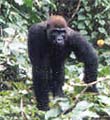Saving The Cross River Gorillas
Posted by: Loren Coleman on December 4th, 2008

With only 200 to 300 in their entire population, the Cross River gorilla* is rarely photographed in the wild.

Closeup of the Cross River gorilla’s face.
A new park has been created and announced in the African country of Cameroon to try to protect a critically endangered subspecies of gorilla.
There are only thought to be about 300 Cross River gorillas left in the world and up to 115 of them are living in the Takamanda National Park.
Part of the problem they face is from hunters and people who cut down trees in the forests where they like to live.
But animal experts say the new national park should help to stop that threat.
Sreven Sanderson from the Wildlife Conservation Society said the creation of the park sent a powerful message to the world about conservation.
“The government of Cameroon is to be commended for taking this step in saving the Cross River gorilla for future generations,” he said.
+++
*The Cross River Gorilla (Gorilla gorilla diehli) is a subspecies of the Western Gorilla (Gorilla gorilla) that can be found on the border between Nigeria and Cameroon, in both tropical and subtropical moist broadleaf forests. The Cross River Gorilla is the most endangered of the African apes, and is one of the world’s 25 most endangered primates according to the IUCN Primate Specialist Group.
About Loren Coleman
Loren Coleman is one of the world’s leading cryptozoologists, some say “the” leading living cryptozoologist. Certainly, he is acknowledged as the current living American researcher and writer who has most popularized cryptozoology in the late 20th and early 21st centuries.
Starting his fieldwork and investigations in 1960, after traveling and trekking extensively in pursuit of cryptozoological mysteries, Coleman began writing to share his experiences in 1969. An honorary member of Ivan T. Sanderson’s Society for the Investigation of the Unexplained in the 1970s, Coleman has been bestowed with similar honorary memberships of the North Idaho College Cryptozoology Club in 1983, and in subsequent years, that of the British Columbia Scientific Cryptozoology Club, CryptoSafari International, and other international organizations. He was also a Life Member and Benefactor of the International Society of Cryptozoology (now-defunct).
Loren Coleman’s daily blog, as a member of the Cryptomundo Team, served as an ongoing avenue of communication for the ever-growing body of cryptozoo news from 2005 through 2013. He returned as an infrequent contributor beginning Halloween week of 2015.
Coleman is the founder in 2003, and current director of the International Cryptozoology Museum in Portland, Maine.










I hope the park is successful. Does anybody know what distinguishes these “Cross River gorillas” from other lowland gorillas?
amazing
What’s needed, in addition to protection, is a massive global campaign to educate third-world countries about how fragile our ecosystems are and that these creatures aren’t ingredients in completely ineffective virility cocktails or necessary to ward off some curse.
Wasn’t it Esteban Sarmiento, who found out, that the cross river gorilla was a distinct subspecies?
Jayman- The Cross River gorillas have different skull and tooth dimensions than the lowland gorillas. They were once thought to be the same as Western lowland gorillas Gorilla gorilla, but these difference in skull morphology were considered dramatic enough to classify them as a separate subspecies.
It’s interesting also that after the war in Nigeria in the 1960s, the Cross River gorilla was considered extinct until it was rediscovered in the 1980s.
Another physical difference between the two, if I remember correctly, is that male Cross River gorillas tend to have sagittal crests that are relatively poorly developed or even absent.
Christoph- I’m not sure what you mean by “found out”. The Cross River gorilla was first described as a different species in 1904 by zoologist Paul Matschie, based on skull and tooth differences from a few specimens. Subsequent classifications found that they were not a new species, but rather a subspecies and they were classified as Gorilla gorilla Diehli. Harold Coolidge redifined the genus Gorilla in 1929 to make them all one species which ended up leading to the eventual classification of the Cross River gorillas as just local populations of Western lowland gorillas Gorilla gorilla gorilla.
Note that gorillas are currently seen as two species, Eastern gorillas, and Western gorillas. Anyway for a long time the Cross River gorillas were seen as the same as the same as Western lowland gorillas, which themselves would now be considered a subspecies of Western gorilla. Confused yet? 🙂
In 2001, Sarmiento and Oates took another look another look at the distinctive features of this gorilla and revived them as a separate subspecies of the Western gorilla, but it is Matschie who actually first “found out” they were different than other gorillas and described them as such.
good luck